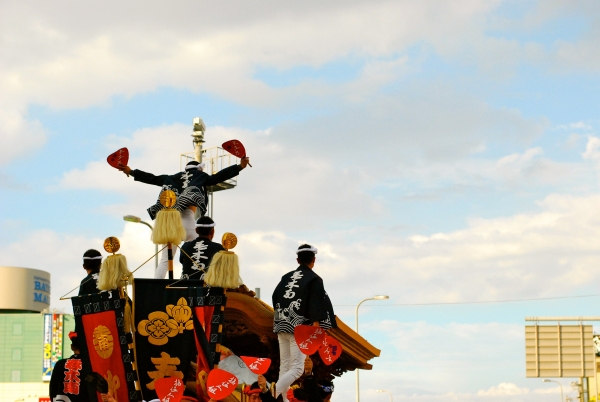A tradition of thrills, spills, and community at the Kishiwada Danjiri Festival

Walking down the steps of Kishiwada Station (岸和田駅 Kishiwada-eki) towards the main ticket gates, you can already feel a buzz in the air as you step out into the undulating and raucous crowds of the Kishiwada Danjiri Festival (岸和田だんじり祭り Kishiwada-danjiri-matsuri). Japanese festivals, in general, are known for their animated atmosphere and throngs of jubilant festival-goers, but there’s a different kind of excitement, something almost dangerous, that accompanies this event. The electricity in the streets is reminiscent of the running of the bulls in Pamplona, Spain; a primal energy draws you forward, tempered by excited caution and nervous anticipation. And rightfully so. No other festival in Japan boasts a record of accidents, injuries, and deaths on the level of Kishiwada’s Danjiri Festival. Yet while the looming threat of some cataclysmic crash is surely part of this festival’s pull, Kishiwada’s other attraction, hidden behind the flare of careening wooden floats, is a story of age-old communal bonds uniting working-class communities.
If only for a day or two, the Kishiwada Danjiri Festival offers a glimpse of a Japan untouched by the transformations and demands of modern society. There’s a sense you’re seeing Kishiwada’s people and neighbourhoods as they once were and ideally strive to be. And this, combined with the festival’s many thrills and spills, is what makes Kishiwada’s danjiri (だんじり) unlike any other festival in Japan.
Ancient roots
Children representing their local neighbourhood. (Image credit: Josh Grengs)
Believed to have started in 1703, the Kishiwada Danjiri Festival is a 300-year-old tradition that began in prayer to the gods for a bountiful autumn harvest. Now held twice a year in September and October, the festival features a fleet of wooden floats representing each of the 34 neighbourhoods that comprise Kishiwada. The main festival takes place over two days in September on the Saturday and Sunday before Respect for the Aged Day (敬老の日 Keirō-no-hi). In sticking to custom, the festival follows time-honoured routes established centuries ago around Kishiwada Castle (岸和田城 Kishiwada-jō) and its environs. On the first day of the festival, the wooden floats are paraded past Kishiwada Station through shopping arcades and tightly packed streets in a labyrinthian circuit that will leave many outsiders feeling lost. The second and final day of the festival takes place in the neighbourhoods around Kishiwada Castle. While at a glance Kishiwada’s danjiri may appear to be much like those at other festivals across Osaka Prefecture (大阪府 Ōsaka-fu), it doesn’t take long to recognise that something quite different is happening here.
The floats
Men pulling their community float. (Image credit: Josh Grengs)
Kishiwada’s wooden danjiri floats are remarkable not just in their number, but also their size, and ornamentation. Standing 3.8m tall and weighing in at around four tonnes, these massive sacred carts have been painstakingly adorned with various historical scenes carved carefully into their wooden facades. And with one float representing each of Kishiwada’s 34 neighbourhoods, the procession they comprise can at times feel endless. To move these mammoth vehicles, teams of over 200 people pull on a set of ropes that stretch up to 100m in front of the float. Additional members help steer from behind. Strengthening the sense of communal spirit embodied by the various neighbourhoods, each team dons its own distinct uniform and colours, with local residents joining in to cheer on their respective community. Indeed, the wooden floats serve as a centrepiece uniting neighbourhoods with their ancestors down through the ages.
The performance
Another local neighbourhood taking part in the festival. (Image credit: Josh Grengs)
The highlight of the Kishiwada Danjiri Festival’s parade of wooden floats is without a doubt the yarimawashi (やりまわし) or corner turns. Unlike other danjiri festivals where the portable shrines cautiously and slowly navigate the corners of the course, Kishiwada’s floats break into a full-on sprint, using the momentum of the danjiri to lurch around each turn before settling back into a walking pace. To add to the thrilling spectacle of the yarimawashi, local carpenters or daikugata (大工方) who craft the wooden floats stand on top of the roof dancing from side to side, as the team turns each 90-degree corner. What’s more, all of this is accompanied by a constant, trance-like musical arrangement of drums, bells, and flutes.
A tranquil conclusion

A daikugata stands atop his neighbourhood float. (Image credit: Josh Grengs)
As night moves in and the teams and floats finish their final exhilarating laps, those who were lucky enough to escape unscathed from the day’s festivities begin preparing for a completely different type of procession. For hiire-eiko (灯入れ曳行), each wooden float erects a tower of approximately 200 lanterns and proceeds slowly and solemnly down the same streets that just hours before were rumbling with racing teams of portable shrines. Night brings the opportunity to relax with members of one’s community over a glass of beer or cold cup of Japanese sake, and to recount all the day’s events. Food stalls abound, offering tasty traditional snacks to replenish lost calories from hours of standing on one’s feet. It is here in the subdued afterglow of the day’s frenzied procession that one realises at least for today they were part of something truly special. Today, they belonged.
Getting there
From JR Osaka Station (大阪駅 Ōsaka-eki), take the JR Osaka Loop Line (大阪環状線 Ōsaka kanjō-sen) bound for Nishikujo (西九条駅 Nishikujō-eki) and get off at Shin-Imamiya Station (新今宮駅 Shin-Imamiya-eki). Transfer to the Nankai Airport Line (南海空港線 Nankai Kūkō-sen) and take the Airport Express to Kishiwada Station. After exiting Kishiwada Station, you will see the Kishiwada Danjiiri Festival being held immediately outside the station.
Kishiwada Danjiri Festival (岸和田だんじり祭り)
Dates: Mid-September (Weekend before Respect for Aged Day in September) and early October (annually)
Address: Just outside Kishiwada Station on the Nankai Line
Nearest station: Kishiwada Station (岸和田駅)
Hours: 6am–10pm
Header image credit: Josh Grengs





